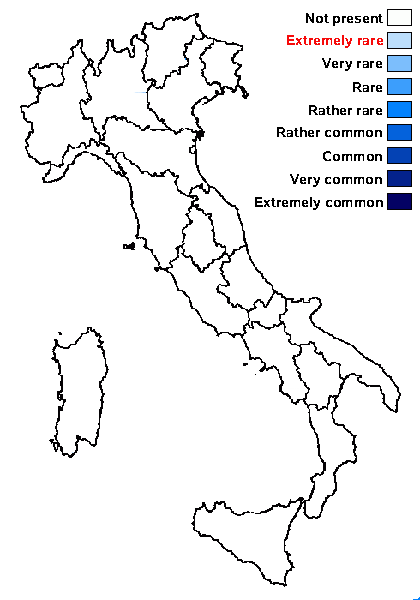Arthonia breussii F.Berger & E.Zimm.
Herzogia, 38,1: 52, 2025.
Synonyms:
Distribution:
Description: Thallus inapparent, not lichenized, the hyphae penetrating into the upper cortex and algal layer of the squamules of a terricolous Placidium. Apothecia arthonioid, black, glossy, epruinose, clustered to contiguous, round to irregular in outline, flat to slightly convex, 0.1- 0.3 mm across, at first c. 2/3 immersed, later more erumpent, without a proper margin. Proper exciple absent; epithecium olive-grey with a bluish or violet tinge c. 10-18 μm high, K+ dark olive, K/I+ slowly brown, N-; hymenium grey, sometimes with a violet tinge in upper part, 55-80 μm high, K+ dark olive, the lower half paler, I+ wine-red, K/I+ blue; paraphysoids c. 2-2.5 μm thick, branched and bending over the asci in upper part, the apical cells irregularly swollen, up to 5 μm wide, with an olive-green, greyish or bluish black pigment lining the wall; hypothecium colourless to pale brown, c. 30-50 μm high. Asci (6-)8-spored, bitunicate, pyriform to broadly clavate, the tholus thick, with a distinct ocular chamber, without a K/I+ apical ring, the gel I+ orange. Ascospores 1-septate, not constricted at septum, hyaline, ellipsoid or slightly tapering to the lower end, (13-)15-16(-18) x (4.8 -)5-6(-7) μm, occasionally with a thin halo. Photobiont absent. Spot tests: all negative. Chemistry: without lichen substances.Note: a recently-described lichenicolous fungus developing on the squamules of a species of Placidium. Hitherto known only from the type locality in the northern calcareous Alps of Austria at 1660 m. For further details see Berger & Zimmermann (2025). To be looked for in the Italian Alps.
Growth form: Lichenicolous fungus
Substrata: soil, terricolous mosses, and plant debris
Reproductive strategy: mainly sexual

Predictive model

Photo by E. Zimmermann. -Source: Berger F., Zimmermann E. 2025. Contribution to the knowledge of the lichenicolous mycobiota of the Alps II. – Six new species from Austria and Switzerland. Herzogia, 38, 1: 51- 69. Courtesy of the authors
Austria, Upper Austria, Bez. Kirchdorf, Spital am Pyhrn, Naturschutzgebiet Warscheneck Süd, am Wanderweg ''218'', old Pinus cembra-Larix decidua forest, 1660 m, 47°38'29''N/14°15'42''E, MTB 8351, on upper cortex of Placidium cf. squamulosum on earth filled crack, 30.6.2010, Berger
Ascomata on Placidium cf. squamulosum - Holotype. Scale bar: 1 mm
Growth form: Lichenicolous fungus
Substrata: soil, terricolous mosses, and plant debris
Reproductive strategy: mainly sexual

Predictive model


